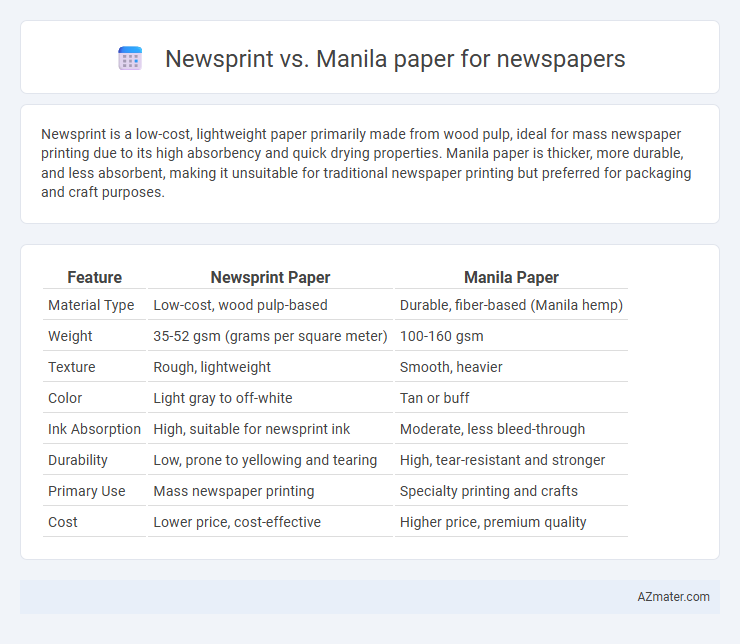Newsprint is a low-cost, lightweight paper primarily made from wood pulp, ideal for mass newspaper printing due to its high absorbency and quick drying properties. Manila paper is thicker, more durable, and less absorbent, making it unsuitable for traditional newspaper printing but preferred for packaging and craft purposes.
Table of Comparison
| Feature | Newsprint Paper | Manila Paper |
|---|---|---|
| Material Type | Low-cost, wood pulp-based | Durable, fiber-based (Manila hemp) |
| Weight | 35-52 gsm (grams per square meter) | 100-160 gsm |
| Texture | Rough, lightweight | Smooth, heavier |
| Color | Light gray to off-white | Tan or buff |
| Ink Absorption | High, suitable for newsprint ink | Moderate, less bleed-through |
| Durability | Low, prone to yellowing and tearing | High, tear-resistant and stronger |
| Primary Use | Mass newspaper printing | Specialty printing and crafts |
| Cost | Lower price, cost-effective | Higher price, premium quality |
Introduction to Newspaper Printing Materials
Newsprint is the most common material used in newspaper printing due to its cost-effectiveness, lightweight nature, and ability to hold ink well for clear text reproduction. Manila paper, thicker and more durable, is less commonly used but offers superior strength and resistance to tearing, making it suitable for special editions or insert sections. Choosing between newsprint and manila paper depends on factors such as print quality, budget constraints, and the intended lifespan of the newspaper.
What is Newsprint?
Newsprint is a low-cost, non-archival paper primarily used in newspaper printing due to its lightweight and high opacity, which enhances print clarity while minimizing ink bleed-through. Made from mechanical wood pulp, newsprint is designed to be highly absorbent, allowing fast ink drying and efficient mass production at lower costs compared to alternatives like Manila paper. Unlike Manila paper, which is thicker and more durable for packaging or crafts, newsprint's lightweight quality ensures economical bulk printing and easy handling in newspaper presses.
What is Manila Paper?
Manila paper is a durable, inexpensive type of paper made from Manila hemp fibers, known for its strength and resistance to tearing. Unlike newsprint, which is lightweight and made from wood pulp designed primarily for mass newspaper printing, Manila paper is thicker and often used for covers, folders, and artistic purposes. Its coarse texture and durability make it less suitable for standard newspaper printing but ideal for packaging and creative projects requiring a sturdy paper material.
Key Differences Between Newsprint and Manila Paper
Newsprint is a low-cost, lightweight paper primarily used for printing newspapers due to its high opacity and quick ink absorption, whereas Manila paper is thicker, more durable, and often used for artwork or crafts rather than mass printing. Newsprint has a rough texture and is typically made from recycled wood pulp, making it less resistant to wear and yellowing compared to the smoother and stronger manila paper crafted from cotton or hemp fibers. The primary difference lies in their purpose: newsprint prioritizes cost-efficiency and print quality for short-term use, while manila paper offers greater strength and longevity for archival or decorative applications.
Print Quality Comparison
Newsprint offers a lower print quality compared to Manila paper due to its coarse fibers and higher absorption rate, resulting in less sharp and vibrant images. Manila paper, being smoother and denser, provides crisper text and more vivid color reproduction, which enhances readability and visual appeal. For newspapers prioritizing striking visuals and clarity, Manila paper is the superior choice despite its higher cost and weight.
Cost Efficiency: Newsprint vs Manila Paper
Newsprint is significantly more cost-efficient than Manila paper for newspaper production due to its lower raw material and manufacturing expenses, making it ideal for high-volume printing. Manila paper, with its heavier weight and superior durability, incurs higher costs, which increases overall production expenses for newspapers. Choosing newsprint allows publishers to reduce material costs while maintaining adequate print quality for daily circulation.
Environmental Impact of Both Papers
Newsprint, primarily made from recycled fibers and wood pulp, has a lower environmental footprint compared to Manila paper, which is typically produced from abaca fibers requiring more energy-intensive processing. Newsprint's high recyclability and biodegradability contribute to reduced landfill waste and lower carbon emissions during production and disposal. Conversely, Manila paper's durability and resistance to moisture make it less biodegradable, resulting in a more prolonged environmental impact when discarded.
Durability and Longevity in Newspaper Use
Newsprint offers a cost-effective, lightweight option for newspapers but lacks durability and tends to yellow and become brittle over time, limiting its longevity. Manila paper provides enhanced durability with thicker fibers and better resistance to tearing and moisture, making it more suitable for newspapers requiring extended preservation. Choosing between the two depends on balancing budget constraints with the need for longer-lasting print quality and structural integrity.
Industry Preferences and Trends
Newsprint remains the dominant choice for newspaper printing due to its cost-effectiveness, lightweight nature, and compatibility with high-speed presses, making it ideal for daily circulation. Manila paper, favored for specialized inserts and artistic prints, is less common in mainstream newspaper production because of its higher durability and premium texture, which comes at an increased cost. Industry trends indicate a gradual shift towards eco-friendly newsprint options with recycled content to meet sustainability goals while maintaining print quality.
Final Thoughts: Choosing the Right Paper for Newspapers
Newsprint offers cost-effective, lightweight, and high-opacity qualities ideal for mass-distributed newspapers prioritizing affordability and quick consumption. Manila paper, with its durability and heavier texture, suits special editions or archival purposes where longevity and presentation matter. Selecting between newsprint and manila paper depends on balancing budget constraints, readership experience, and the newspaper's intended lifespan.

Infographic: Newsprint vs Manila paper for Newspaper
 azmater.com
azmater.com